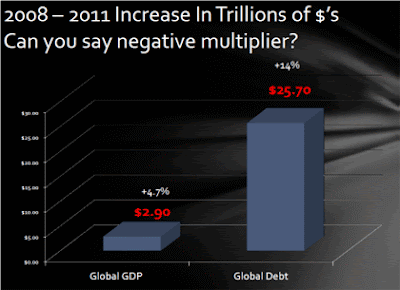I was particularly interested in looking at those taxpayers in the $50,000-$200,000 range in adjusted gross income. There were 43.7 million returns filed for these income ranges in 2009. You might call this "The Middle" as this probably represents a broad definition of what many would consider middle income taxpayers in the United States. However, recognize that there were 93 million returns filed with incomes below $50,000 and about 4 million filed with incomes of $200,000 or above.
Consider these facts about "The Middle"(incomes between $50k-$200k).
- $4.1 trillion out of total reported income of $7.7 trillion were to those in The Middle (53% of the total)
- $3.1 trillion of $5.7 trillion in salaries and wages were earned by The Middle (54%)
- $59 billion of $168 billion in interest income was earned by The Middle (35%)
- $51 billion of $163 billion in dividends was earned by The Middle (31%)
- $218 billion of $362 billion in capital gain distributions (principally from mutual fund investing) were earned by The Middle (60%)
- $35 billion of $240 billion in long term capital gains came from The Middle (15%)
- $484 billion of $823 billion of pensions and annuities came from The Middle (59%)
- $677 billion out of $1.2 trillion in itemized deductions were from The Middle (56%)
- $2.7 trillion out of $5.1 trillion in taxable income came from The Middle (53%)
- $371 billion out of $866 billion in total income taxes were paid by The Middle (43%)
Consider these facts about "The Rich"( incomes over $200k)
- $2.0 trillion out of total reported income of $7.7 trillion were to The Rich (26%)
- $1.1 trillion of $5.7 trillion in salaries and wages were earned by The Rich (19%)
- $64 billion of interest income of $168 billion in interest income was earned by The Rich (38%)
- $86 billion of $163 billion in dividends were earned by The Rich (53%)
- $41 billion of $363 billion in capital gain distributions were earned by The Rich (11%)
- $185 billion of $240 billion in long term capital gains came from The Rich (77%)
- $102 billion of $823 billion of pensions and annuities came from The Rich (12%)
- $305 billion out of $1.2 trillion in itemized deductions were from The Rich (25%)
- $1.6 trillion out of $5.1 trillion in taxable income came from The Rich (31%)
- $434 billion out of $866 billion in total income taxes were paid by The Rich (50%).
A few observations.
- The Middle earns the bulk of the salaries and wages (54%), capital gains distributions (60%), and pensions and annuities (59%). They also claim more than half of the itemized deductions (56%). In fact, the amount of these deductions is also more than twice what The Rich claim (25%).
- The Rich are rich not due to the their salaries and wages (they only account for 19% of the salaries compared to 54% for The Middle) but because of their investments. 53% of the dividends and 77% of the long term capital gains were earned by The Rich.
- The Middle had 53% of the taxable income but paid 43% of the total income taxes. The Rich had 31% of the taxable income but paid 50% of all income taxes. Despite what you may hear from time to time, this is a very progressive tax system. Those below The Middle pay almost nothing in income taxes. Those in The Middle are also big beneficiaries of the current tax system.
- The only way to raise any substantial amount of additional taxes on The Rich is to increase tax rates on dividends and capital gains. However, you could tax both of these items at a 100% tax rate on the rich and you only would only reduce this year's projected budget deficit by less than 30%.
- The only way to raise significant amounts of income tax revenues is to increase tax rates on incomes in The Middle. As you can see from the statistics above, this is where the bulk of the income earned in this country comes from and this is the group that benefits the most from the large numbers of deductions and credits.





